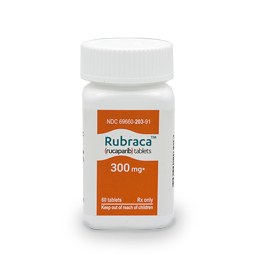Rubraca (rucaparib) vs Orserdu (elacestrant)
Rubraca (rucaparib) vs Orserdu (elacestrant)
Rubraca (rucaparib) is a PARP inhibitor used primarily for the treatment of certain types of ovarian, fallopian tube, or primary peritoneal cancer in patients who have received previous chemotherapy and have specific BRCA gene mutations. Orserdu (elacestrant), on the other hand, is an estrogen receptor antagonist used for the treatment of estrogen receptor-positive breast cancer, often in postmenopausal women. When deciding between these medications, it is crucial to consider the type of cancer, the presence of specific genetic mutations, hormone receptor status, and previous treatments, as each drug is tailored for different cancer profiles and mechanisms of action.
Difference between Rubraca and Orserdu
| Metric | Rubraca (rucaparib) | Orserdu (elacestrant) |
|---|---|---|
| Generic name | Rucaparib | Elacestrant |
| Indications | Ovarian cancer, fallopian tube cancer, primary peritoneal cancer | Advanced or metastatic breast cancer |
| Mechanism of action | Poly (ADP-ribose) polymerase inhibitor | Estrogen receptor degrader |
| Brand names | Rubraca | Orserdu |
| Administrative route | Oral | Oral |
| Side effects | Nausea, fatigue, vomiting, anemia, dysgeusia, constipation, decreased appetite, diarrhea, thrombocytopenia, abdominal pain, dyspnea, asthenia, neutropenia, rash, elevated liver enzymes, and others | Not fully characterized yet, as the drug is in clinical development |
| Contraindications | Hypersensitivity to rucaparib or any component of the formulation | Not fully characterized yet, as the drug is in clinical development |
| Drug class | PARP inhibitor | Selective estrogen receptor degrader (SERD) |
| Manufacturer | Clovis Oncology | Radiant Pharmaceuticals |
Efficacy
Rubraca (rucaparib) Efficacy in Gynecological Cancer
Rubraca (rucaparib) is a poly (ADP-ribose) polymerase (PARP) inhibitor approved for the treatment of certain types of gynecological cancers, specifically ovarian cancer, fallopian tube cancer, and primary peritoneal cancer. It is indicated for patients with deleterious BRCA mutation (germline and/or somatic)-associated epithelial ovarian, fallopian tube, or primary peritoneal cancer who have been treated with two or more chemotherapies. The efficacy of Rubraca was demonstrated in clinical trials where it was shown to significantly delay disease progression compared to placebo. In patients with BRCA-mutated ovarian cancer who had received two or more chemotherapies, Rubraca improved progression-free survival (PFS), which is a primary endpoint for many cancer treatments.
Rubraca's effectiveness has also been evaluated in the maintenance treatment setting. In this context, it is used following the complete or partial response to platinum-based chemotherapy. Clinical studies have shown that Rubraca can extend the time without disease progression in this maintenance setting. This benefit provides a valuable option for patients with recurrent ovarian cancer, which is often difficult to treat. The response rates and duration of response have been encouraging, with a subset of patients experiencing long-term stabilization of their disease.
Orserdu (elacestrant) Efficacy in Gynecological Cancer
Orserdu (elacestrant) is a newer agent and is a selective estrogen receptor degrader (SERD). While Orserdu has shown promise in the treatment of estrogen receptor-positive (ER+) breast cancer, there is limited data regarding its efficacy in gynecological cancers. However, given the hormonal dependence of certain gynecological cancers, there is potential for the application of SERDs like Orserdu in the treatment of these diseases. Clinical trials and research are ongoing to explore the efficacy of Orserdu in gynecological cancers, including those of the ovary, endometrium, and cervix, which may express estrogen receptors.
It is important to note that the efficacy of medicines can vary based on the specific type of gynecological cancer, the presence of certain biomarkers, previous treatments, and the patient's overall health. As with any medication, the use of Rubraca and Orserdu should be guided by a healthcare professional, taking into account the individual characteristics of the patient and the specifics of their disease. Clinical trials and real-world evidence continue to shape our understanding of how best to use these medications in the treatment of gynecological cancers.
Regulatory Agency Approvals
Rubraca
-
European Medical Agency (EMA), European Union

-
Food and Drug Administration (FDA), USA

Orserdu
-
Food and Drug Administration (FDA), USA

Access Rubraca or Orserdu today
If Rubraca or Orserdu are not approved or available in your country (e.g. due to supply issues), you can access them via Everyone.org.
How it works

Make an enquiry
Choose the medicine you want to buy, answer a couple of questions, and upload your prescription to speed things up. We’ll get back to you within 24 hours.


Make an enquiry
Choose the medicine you want to buy, answer a couple of questions, and upload your prescription to speed things up. We’ll get back to you within 24 hours.


Breeze through the paperwork
We'll guide you through the required documents for importing unapproved medicine, ensuring you have all the necessary information.


Get a personalized quote
We’ll prepare a quote for you, including medicine costs and any shipping, administrative, or import fees that may apply.


Receive your medicine
Accept the quote and we’ll handle the rest - sourcing and safely delivering your medicine.

Some text on this page has been automatically generated. Speak to your physician before you start a new treatment or medication.
Let's talk
If you have any questions, call us or send us a message through WhatsApp or email:
Contact us




